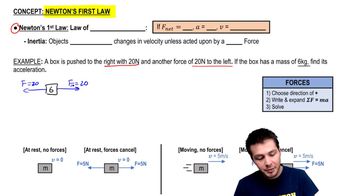Here are the essential concepts you must grasp in order to answer the question correctly.
Newton's Laws of Motion
Newton's Laws of Motion describe the relationship between the motion of an object and the forces acting on it. The first law states that an object at rest will remain at rest unless acted upon by a net external force. The second law quantifies this relationship, stating that the acceleration of an object is directly proportional to the net force acting on it and inversely proportional to its mass (F=ma). The third law states that for every action, there is an equal and opposite reaction.
Recommended video:
Tension in a Rope
Tension is the force transmitted through a rope or string when it is pulled tight by forces acting from opposite ends. In a frictionless pulley system, the tension is constant throughout the rope. This means that the tension acting on the hanging mass is equal to the weight of the mass minus any other forces acting on the system, such as the weight of the boot in this scenario.
Recommended video:
Calculating Tension in a Pendulum with Energy Conservation
Equilibrium of Forces
An object is in equilibrium when the net force acting on it is zero, meaning all forces are balanced. In the context of the problem, the forces acting on the boot and the hanging mass must balance out. This involves considering the gravitational force acting on the masses and the tension in the rope, allowing us to set up equations to solve for unknowns, such as the tension in the rope.
Recommended video:

 Verified step by step guidance
Verified step by step guidance


